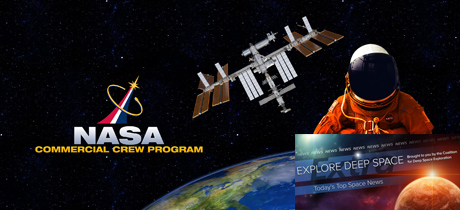In Today’s Deep Space Extra… Hawaii’s Mauna Loa offers NASA backed researchers a healthy taste of life on Mars. China focuses on lunar exploration. International Space Station astronaut demonstrates techniques for identifying DNA based life in space. 2018 looms large for NASA’s Commercial Crew Program.
Human Space Exploration
Scientific American (1/2): “Make no mistake, sending humans to Mars is much more than just a technical challenge,” writes physicist Christiane Heinicke, part of a six-member team that spent 365 days sheltered on the remote Mauna Loa volcano in Hawaii as part of a NASA financed study of the psychological challenges associated with a two to three-year journey to the red planet. “Each one of us brought to the project different personality traits, experiences, attitudes and work habits.”
Report calls for ISS research transition plan and use of alternative platforms
Space News (1/2): In a recent report, the National Academy of Sciences calls on NASA to make the most of the International Space Station as a research platform to investigate the health challenges facing astronauts assigned to future missions of human deep space exploration. The agency should complete a transition strategy and consider alternative research platforms where it can, according to the assessment that was released on December 15.
IEEE Spectrum (1/1): Despite mission failures, China appears determined to become the third nation after the U.S. and Russia to land a spacecraft on the moon. Though Beijing has not provided details, human exploration is intended sometime between 2025 and 2050. A Chinese robotic lunar sample return is possible by 2019, accompanying planned reconnaissance of the lunar poles for the identification of resources for future exploration.
Will commercial crew come through in 2018?
Parabolic Arc (1/3): Astronauts have not launched from U.S. soil since the retirement of NASA’s space shuttle in July 2011. Challenged financially and technically, NASA’s Commercial Crew Program intends to mend the lapse with uncrewed and crewed test flights of Boeing’s CST-100 Starliner and SpaceX’s Crew Dragon by year’s end. Until the two spacecraft are certified by NASA for astronaut launches and landings, Russia’s Soyuz will continue to offer the only human access to the International Space Station.
Space Science
Astronauts identify mystery microbes in space for the 1st time
Space.com (1/2): Former International Space Station astronaut and biochemist Peggy Whitson used a pair of DNA analysis tools to identify microbes collected aboard the orbiting laboratory prior to her return to Earth on September 2, 2017. The first for space could help to diagnose astronaut illness when they are on deep space missions, as well as to assess the environmental health of their spacecraft and habitats. The techniques may prove useful in assessing planetary surfaces for signs of DNA based life as well.
2018’s meteor showers that will light up night skies
New York Times (1/2): Darkened clear skies, an unobstructed view and the naked eye can make for good viewing of a string of 2018 meteor showers. The Quadrantids, peaks tonight and fades by January 12. Next up: the Lyrids, April 14-30. The Eta Aquariids, whose source is comet Halley, runs from April 19 to May 28.
Other News
2018 may (almost) be the year for commercial human suborbital spaceflight
The Space Review (1/2): The debut of suborbital passenger spaceflight appears to be nearing, especially for Blue Origin and Virgin Galactic. But enthusiasm has mounted before only to wane in the face of new challenges, even tragedy. It could be that scientists and engineers with new experiments or hardware awaiting flight opportunities will open the door for future tourists.
World View sees strong interest in stratospheric balloons despite test incident
Space News (1/2): World View, the Tucson, Arizona, based high altitude science and passenger balloon service, predicts more frequent and longer missions as the company transitions into 2018. The outlook, presented by CEO Jayne Poynter at the recent Next-Generation Suborbital Researchers Conference, preceded the rupture of a hydrogen rather than helium filled balloon during a ground test that caused some damage to surrounding properties.
SpaceX leases Cape Canaveral home for Crew Dragon
Florida Today (1/1): SpaceX has leased a previous satellite processing facility at Cape Canaveral Air Force Station, Florida, where it will prepare its crewed Dragon capsules for launches to the International Space Station with astronauts. Uncrewed and crewed test flights are planned in 2018 as part of NASA’s Commercial Crew Program.
Why the U.S. should notify the public of all satellite reentries
The Space Review (1/2): How much should the owner/operators of aging or crippled satellites about to re-enter the Earth’s atmosphere reveal about the event ahead of time. Charles Phillips, a former U.S. military orbital analyst and NASA space shuttle flight controller, argues more than is currently disclosed.

